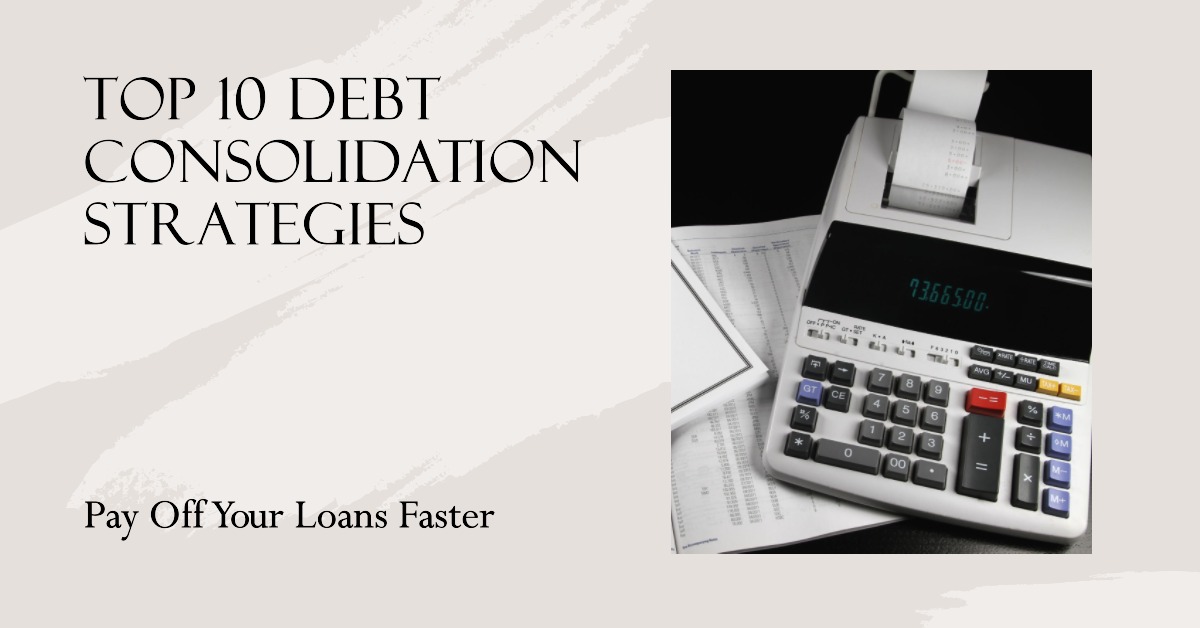Are you struggling to pay off your loans faster? Debt consolidation is an effective strategy for managing multiple loan payments. With the right strategies, you can simplify and streamline your debt repayment plan so that you can quickly get out of debt. In this article, we’ll explore ten strategies to help you consolidate your debts and pay them off faster. We’ll cover topics such as creating a comprehensive repayment plan, exploring balance transfer credit cards, taking advantage of personal loans, and more. Read on for tips on how to successfully manage your debt and become debt-free sooner than later.
Create a Comprehensive Debt Repayment Plan
Creating a comprehensive debt repayment plan is key to paying off loans faster–it’s the foundation of all successful strategies. To develop an effective repayment plan, you must first analyze your current financial situation and determine how much money you can realistically allocate each month towards loan payments. After evaluating your income, expenses, and any additional funds available for payments, it’s important to create a budget that outlines where your money will be allocated. Once a budget is in place, you can prioritize your debts and make sure the most essential bills are paid on time while also allocating funds towards loan repayments. By creating a thorough and organized debt repayment plan, you’re taking the first step towards quickly paying off your loans.
Explore Balance Transfer Credit Cards
Exploring balance transfer credit cards can be like paddling downstream: taking advantage of the current to make swift progress. It is a strategy that involves transferring the balance from one credit card to another with a lower rate or promotional period. This type of card typically offers an introductory period with no interest or low interest rates, which often lasts between six and 18 months. The goal for many who use this method is to pay off their debt before the end of the promotional period when regular interest rates are applied. Balance transfers also come with fees, so it’s important to understand them before committing to this option in order to ensure that you won’t be spending more money than necessary. Additionally, some credit cards may have limits on how much can be transferred at a time or restrictions on what types of balances can be transferred, so it’s important to do research and read through all terms and conditions carefully before signing up for a new card.
Take Advantage of Personal Loans
Navigating the world of personal loans can be like taking a shortcut to debt relief. Taking advantage of them can be an effective way to consolidate high-interest debt and help you pay off your loans faster. Personal loans are typically unsecured loans with fixed payments over a set period of time, and they often come with lower interest rates than credit cards. They also tend to have fewer fees associated with them, making them more attractive than other types of financing. Before applying for a personal loan, you should consider all the factors involved including how much you need to borrow, what type of repayment term is best for you, and what kind of interest rate you qualify for. Shopping around for competitive rates is important as some lenders may offer better terms than others. Finally, it’s wise to create a budget and stick to it so that your debt does not become unmanageable again in the future.
Home Equity Loans or Lines of Credit
Unlocking the potential of your home’s equity can be a great way to access cash, and Home Equity Loans or Lines of Credit are two popular options. A Home Equity Loan (HEL) is a type of loan that allows you to borrow money against the value of your home. The interest rate on this type of loan is usually fixed and you’ll have a set repayment schedule over a predetermined period. A Home Equity Line of Credit (HELOC) works in much the same way as a HEL, but offers more flexibility because it allows you to draw down funds when needed and pay them back at any time during the borrowing period without penalty. However, with both types of loans, it’s important to bear in mind that if you default on payments, your home could be put at risk.
Seek Professional Debt Consolidation Services
Considering professional debt consolidation services can be a wise choice to help manage and reduce your outstanding loan obligations. It involves finding a reputable company that specializes in providing this type of service, which may include consolidating multiple loans into one payment with lower interest rates and fees. The company will work with you to develop a plan that fits your individual needs, budget, and timeline for paying off the loan(s). This can include negotiating with creditors on your behalf to reduce or eliminate some of the fees associated with the loan, as well as setting up an automatic payment plan to ensure timely payments are made each month. Additionally, many companies offer counseling sessions to help you better understand how best to manage your finances going forward so you don’t find yourself in this situation again. Overall, seeking out professional debt consolidation services is an effective way to pay off your loans faster while also managing other financial obligations more efficiently.
Debt Snowball Method
Ready to get out of debt? The Debt Snowball Method is an effective way to tackle your loan payments and get back on track. This strategy involves focusing on paying off the smallest debts first, while still making minimum payments on all other debts. Once the smallest debt is paid off, you move onto the next smallest one, until all loans are paid off in full. By seeing results quickly with smaller debts, it can help motivate you to stay focused and stick with the plan. Plus, as you continue to pay down each debt, you will have more money available for larger payments toward your remaining balances. This method may also allow you to save money by consolidating high-interest rate loans into one lower interest loan or balance transfer card.
Debt Avalanche Method
For those looking to tackle their debt quickly, the Debt Avalanche Method is a great option. This strategy focuses on paying off loans with the highest interest rates first, since these loans will accrue more expensive fees over time. By tackling these high-interest debts first, you can save money in the long run and make it easier to pay off your mountain of debt faster than ever before. Additionally, this method encourages borrowers to maintain consistent payments across all debts so as not to fall behind or miss payments altogether. The Debt Avalanche Method is ideal for borrowers who want a structured plan for paying back their debts in a timely manner while minimizing costs associated with accrued interest due to late payments or missed deadlines.
Increase Your Income
If you’re feeling overwhelmed by debt, one of the best ways to tackle it is by increasing your income. To do this, you can take on additional hours at work, switch to a higher-paying job, or start freelancing or consulting in your field. Additionally, searching for extra sources of income such as renting out a room in your house or taking up an online side hustle can be effective strategies for generating more money. Many people have been able to pay off their debts quickly and efficiently with these methods. It’s important to remember that it may take some time and effort to increase your income significantly enough to pay off loans faster; however, it could be well worth the extra effort if you are able to get out of debt sooner than expected.
Cut Back on Expenses
Now that you have explored ways to increase your income, it is time to focus on cutting back on expenses. Reducing unnecessary spending can be difficult but it is a key way to free up more money for debt repayment. Start by tracking all of your expenses and categorizing them into needs and wants. Needs are essential items like groceries, housing, utilities, etc., while wants are anything else. Once you know where your money is going, you can start eliminating the want categories or reducing how much you spend in those areas. It may also be useful to create a budget so that you can keep track of your spending and make sure to stay within certain limits.
Stay Committed to Your Plan
Staying committed to your plan of reducing expenses and boosting income is essential to achieving financial freedom, so it’s important to create a system that works for you. Setting up a direct transfer from your paycheck into a savings account can be an effective way of tracking progress and staying on track. It may also help to set realistic goals, such as paying off small loans first or setting aside money each month to pay toward larger loans. Additionally, it is important to keep track of spending habits and look for areas in which costs can be reduced further. Making use of available budgeting tools like automated reminders or budgeting apps can make this process easier. Having an accountability partner who will check in periodically to ensure you are making progress towards your goals can provide extra motivation when needed. Ultimately, by consistently working towards reducing expenses and increasing income, it is possible to reach the goal of debt consolidation much faster than initially anticipated.
Conclusion
You’ve taken the time to explore your debt consolidation options and have found a plan that will help you pay off your loans faster. You’ve made the commitment to stick to your plan, and you can now see light at the end of the tunnel. It may have seemed like an uphill battle, but with hard work and dedication, you’re on your way to becoming debt-free. Coincidentally, this newfound financial freedom not only brings relief from debt, but also opens up new possibilities for life’s adventures. Congratulations! You’ve done it!



